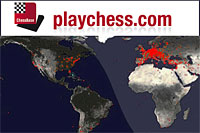
The 2015 U.S. Championship is an elite national championship event, featuring 12 of the strongest chess players in America. Over the course of eleven rounds, these competitors will battle for $175,000 in prize money, qualification into the World Championship cycle, and the coveted title of 2015 U.S. Champion.
U.S. Chess Championship - Final Round
| Table |
White |
Score |
Rating |
Black |
Score |
Rating |
Result |
| 1 |
GM So, Wesley |
5.5 |
2788 |
GM Troff, Kayden W |
5.0 |
2532 |
1-0 |
| 2 |
GM Naroditsky, Daniel |
2.5 |
2633 |
GM Kamsky, Gata |
5.0 |
2683 |
½-½ |
| 3 |
GM Shankland, Samuel L |
4.5 |
2661 |
GM Akobian, Varuzhan |
5.0 |
2622 |
½-½ |
| 4 |
GM Sevian, Samuel |
4.5 |
2531 |
GM Holt, Conrad |
4.5 |
2530 |
1-0 |
| 5 |
GM Nakamura, Hikaru |
7.0 |
2798 |
GM Onischuk, Alexander |
6.0 |
2665 |
1-0 |
| 6 |
GM Gareev, Timur |
4.0 |
2604 |
GM Robson, Ray |
6.5 |
2656 |
0-1 |

Tony Rich, chief arbiter, with one of the main sponsors, Jeanne Sinquefield
So, Wesley 1-0 Troff, Kayden
What a beautiful rebound by Wesley So. After forfeiting his game he won his last two rounds, once against Kamsky and finally against Troff. Black's preparation was a little sketchy, as he found himself down a pawn in a Grunfeld, which seems normal nowadays, but his compensation was nowhere to be found. So easily took a full point and cilnched third place in the tournament.

[Event "U.S. Championship 2015"] [Site "Saint Louis"] [Date "2015.04.12"] [Round "11"] [White "Gareev, Timur"] [Black "Robson, Ray"] [Result "0-1"] [ECO "D01"] [WhiteElo "2604"] [BlackElo "2656"] [Annotator "Josh Friedel"] [PlyCount "65"] [EventDate "2015.??.??"] [EventCountry "USA"] [SourceDate "2015.02.07"] 1. d4 Nf6 2. Nc3 d5 3. Bg5 {Timur likes to put his bishop here early in the game.} c5 $5 {An ambitious move, opting to play a reverse chigorin. Ray knew he'd have to win to catch Nakamura, and fighting chess certainly isn't outside of his comfort zone.} 4. Bxf6 gxf6 5. e4 {White tries to open things up.} dxe4 6. dxc5 Qa5 7. Bb5+ $6 {This check seems to help Black develop. Qd5 and Qh5 look like better moves.} Bd7 8. a4 (8. Bxd7+ Nxd7 {might be best, but this was clearly not the idea of Bb5+.}) 8... a6 $6 (8... e6 {looks direct and strong.}) 9. Ra3 $2 {Timur's crazyness can sometimes throw off his opponents, but this time he does it to himself. This move looks like complete nonsense.} Nc6 10. Nge2 e6 {Black threatens Bxc5, which incidentally hits a rook now.} 11. b4 $2 { Another insane move, which gives away more material.} (11. Nd4 {looks like the best try, but after} O-O-O 12. O-O f5 {Black's position is still to be preferred.}) 11... Qxb4 12. Rb3 Qa5 {c5 is still going to fall, and White has no compensation whatsoever.} 13. O-O {Cause why not?} axb5 {I'm not sure I'd even bother taking this.} (13... f5 {followed by taking on c5 looks easy and allows no chances for a slip up.}) 14. Nxe4 Be7 15. axb5 Ne5 16. N2c3 Rc8 $2 { This gives White a chance to get back in it.} (16... Qc7 17. Nd6+ Kf8 {and White's compensation will evaporate quickly.}) 17. Qd4 $6 (17. Nd6+ Bxd6 18. Qxd6 Qc7 19. Ne4 {looks best, and after} Qxd6 20. Nxd6+ Ke7 21. Nxb7 {White has some counterplay, though Black is still much better.}) 17... Qc7 18. c6 $6 (18. f4 Ng6 19. c6 {is more accurate, since now Nxf6 can be throw in at any time.}) 18... bxc6 19. b6 c5 $1 {Ray finds a key move, and should be easily won again.} 20. Nxf6+ Bxf6 21. Qf4 Qd8 22. Ne4 Ng6 $6 (22... Bg7 {was best according to the computer, laughing at White's Nd6+.}) 23. Qf3 $2 {This move is almost comical.} (23. Nxf6+ Ke7 24. Qg5 {is necessary, and after} h6 25. Nd5+ Kf8 26. Qxd8+ Rxd8 {Black is still much better, but the game can continue. }) 23... Be5 {Now the game is over.} 24. Rd1 Qe7 25. b7 Rb8 26. Rb6 O-O 27. g3 f5 28. Ng5 Bc7 29. Rxd7 Qxd7 30. Rxe6 Bd8 31. Qb3 Kh8 32. Qc3+ Qd4 33. Nf7+ { I really looked forward to this matchup, but it was a bit of a letdown since Timur was basically lost right out of the opening. Congrats to Ray on a very nice tournament.} 0-1
Naroditsky, Daniel ½-½ Kamsky, Gata
Naroditky's position was certainly slightly better against Kamsky.

Kamsky finished tied for fifth, a far cry from defending his U.S. Championship
Shankland, Samuel ½-½ Akobian, Varuzhan
Shankland's deep opening preparation gave him a better position from the opening. The ensuing rook endgame was certainly better for white, but somehow Akobian had no problems holding the endgame. It feels like Shankland could have tortured Akobian for a longer time, but that was not the case and Akobian escaped with a relatively easy draw.
Sevian, Sam 1-0 Holt, Conrad
What a game! Sevian missed an absolutely fantastic way of winning in Holt's pet French line. After missing 27. Nf5!! Black got the initiative since White's attack didn't crash through fast enough. Black's passed b-pawn was a serious advantage which gave him a winning endgame. However, the win was not trivial as Black's king was quite exposed. In a strange turn of events, Holt flagged in what was probably a winning position.
Nakamura, Hikaru 1-0 Onischuk, Alexander
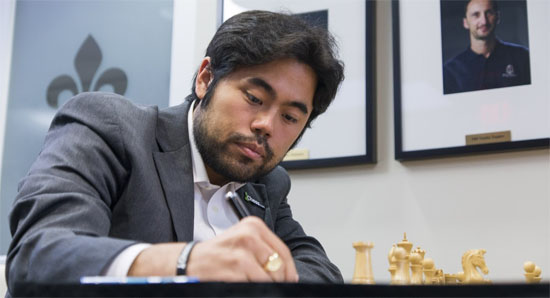
Who else?! 2015 U.S. Champion Hikaru Nakamura showed by far the most solid chess

[Event "U.S. Championship 2015"] [Site "Saint Louis"] [Date "2015.04.12"] [Round "11"] [White "Nakamura, Hikaru"] [Black "Onischuk, Alexander"] [Result "1-0"] [ECO "C55"] [WhiteElo "2798"] [BlackElo "2665"] [Annotator "Josh Friedel"] [PlyCount "61"] [EventDate "2015.??.??"] [EventCountry "USA"] [SourceDate "2015.02.07"] 1. e4 e5 2. Nf3 Nc6 3. d4 exd4 4. Bc4 {Safe to say that the Scotch Gambit was not what Onischuk expected in this game.} Nf6 5. e5 d5 6. Bb5 Ne4 7. Nxd4 Bc5 $5 {An interesting line that attemps to make the game more double-edged.} (7... Bd7 {is the main line.}) 8. Be3 {Best.} (8. O-O O-O $1 {and Bd7 is unnecessary, since the c6 pawn can't safely be grabbed.} 9. Nxc6 bxc6 10. Bxc6 Ba6 $1 {with an initiative.}) 8... O-O {A risky choice by Onischuk, who clearly was trying to mix up the game.} (8... Bd7 {transposes into normal lines.}) 9. Nxc6 bxc6 10. Bxc5 Nxc5 11. Bxc6 Rb8 {The saner choice.} (11... Ba6 {is a move I used to play myself, but unfortunately after} 12. Nc3 $1 {Black's ideas just don't lead anywhere.}) 12. O-O {This leads to a very drawish endgame.} (12. Qxd5 Qe7 13. O-O {is more ambitious for White, but after} Rxb2 14. Nc3 Rxc2 {the game isn't far from equality.}) 12... Rxb2 13. Qxd5 Qxd5 14. Bxd5 Rxc2 15. Na3 { This ending is quite equal. Both the e and c pawns are weak.} Re2 16. Rac1 Nd3 (16... Ne6 {is a simpler way to draw, but Onischuk's move is fine as well.}) 17. Rxc7 Be6 18. Bb3 $1 {Naka keeps the tension, forcing Alex to find acccurate moves.} a5 19. Ra7 Bxb3 20. axb3 Rxe5 $6 {Still drawn, but this makes it more complicated.} (20... g6 {Nd3 was an active move, and it should be followed up actively.} 21. Rxa5 Rb8 22. Rb5 Rxb5 23. Nxb5 Rxe5 {and the b-pawn will be collected in short order.}) 21. Nc4 Rb5 22. Rb1 {It is still well within the draw zone, but black has to play with precision.} Nc5 (22... a4 23. Rxa4 Nc5 24. Ra3 Rfb8 25. Nd2 g6 {and White's chances of winning are pretty slim due to his passive pieces.}) 23. Nxa5 Re8 $2 {Onischuk really starts to slip. The rook just doesn't do enough here.} (23... g6 {followed by Rfb8 is still very drawish.}) 24. g3 g6 25. b4 {White's extra pawn isn't so shabby anymore.} Nd3 26. Nc6 Re2 27. Rd7 Nxf2 $2 {This loses immediately.} ( 27... Rb6 {was forced, and after} 28. Ne7+ Kg7 29. Nf5+ gxf5 30. Rxd3 {White has excellent winning chances, but at least Black can fight on.}) 28. Nd4 Nh3+ 29. Kh1 Nf2+ 30. Kg2 Nd1+ 31. Nxe2 {An abrupt end to the tournament. Onischuk got an easily drawn position, which is perhaps not what he was searching for, but all it takes is a couple inaccuracies to make life difficult. Congrats to Hikaru, who while not playing up to his standards, played well enough to win the event.} 1-0
Gareev, Timur 0-1 Robson, Ray
An almost impossible game to understand. Gareev's Veresov left him in an almost lost position by move 13, and after that Robson simply cleaned up.

An amazing result: Robson with a wonderful second place finish
Final Standings
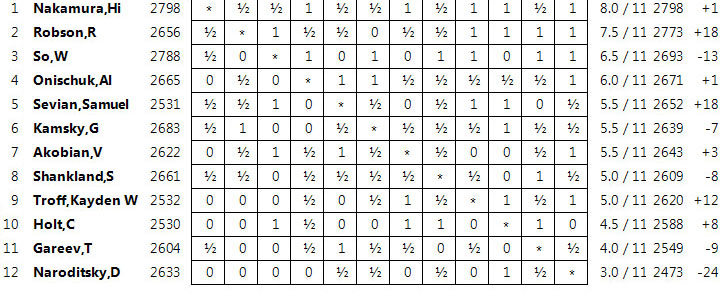
Replay Final Round Games
U.S. Women's Championship - Final Round
| Table |
White |
Score |
Rating |
Black |
Score |
Rating |
Result |
| 1 |
WIM Ni, Viktorija |
6.0 |
2188 |
WCM Virkud, Apurva |
3.5 |
2132 |
1-0 |
| 2 |
IM Paikidze, Nazi |
7.0 |
2333 |
WGM Foisor, Sabina-Francesca |
5.0 |
2235 |
½-½ |
| 3 |
GM Krush, Irina |
8.0 |
2477 |
WGM Nemcova, Katerina |
7.0 |
2279 |
½-½ |
| 4 |
IM Goletiani, Rusudan |
5.5 |
2311 |
WFM Yu, Jennifer R |
2.0 |
2180 |
½-½ |
| 5 |
WGM Sharevich, Anna |
5.5 |
2267 |
WGM Abrahamyan, Tatev |
5.5 |
2322 |
1-0 |
| 6 |
WIM Wang, Annie |
2.5 |
1901 |
FM Melekhina, Alisa |
2.5 |
2235 |
1-0 |
Ni, Viktorija 1-0 Virkud, Apurva
Ni favored a slow Reti position in which she attacked on the kingside, very reminiscent of a King's Indian Defense. Virkud never found counterplay on the queenside, even though she should have blasted open that side as soon as possible. Black's defense was in the long run impossible, and Ni crashed through the kingside with typical sacrifices and won without problems. An excellent finish for an already excellent tournament for Ni, who clinched third.
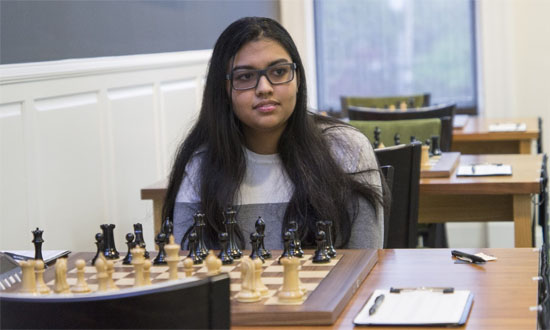
WCM Apurva Virkud: the wildcards did not have a strong event – they finished in the last spots

[Event "U.S. Womens Championship 2015"] [Site "Saint Louis"] [Date "2015.04.12"] [Round "11"] [White "Ni, Viktorija"] [Black "Virkud, Apurva"] [Result "1-0"] [ECO "A06"] [WhiteElo "2188"] [BlackElo "2132"] [Annotator "Josh Friedel"] [PlyCount "93"] [EventDate "2015.??.??"] [EventCountry "USA"] [SourceDate "2015.02.07"] 1. Nf3 d5 2. c4 e6 3. b3 Nf6 4. g3 Be7 5. Bg2 O-O 6. O-O c5 7. Bb2 Nc6 8. e3 b6 9. Qe2 Bb7 10. Rd1 dxc4 11. bxc4 Qc8 $6 {Not the right square for the queen.} ( 11... Qc7 {Is the main move, allowing the rook on a8 to get out.}) 12. d3 {Not a bad move, but I'd try to punish Black a bit more.} (12. Nc3 Rd8 13. Rac1 { followed by d4 would give White a highly favorable hanging pawns structure.}) 12... Rd8 13. Nbd2 {I'm not sure what the knight is doing here.} (13. Nc3) 13... Qc7 {Apurva fixes her queen. Strong players are always willing to admit their mistakes.} 14. e4 $6 {This is entirely the wrong idea, in my opinion.} ( 14. Ne1 {followed by f4 is a very reti-esque idea.}) 14... e5 {The problem is that Nd4 comes before Nd5.} 15. Nf1 Nd4 16. Nxd4 $6 (16. Qe1 {is actually a better choice, in my opinion. The idea is that on} Nc2 17. Bxe5 Qd7 18. Qe2 Nxa1 19. Bxa1 {and White has excellent compensation.}) 16... cxd4 {Black has an excellent reversed King's Indian now. White's attack hasn't started yet, and the queenside is already opened up.} 17. Bc1 Nd7 18. f4 Bd6 $6 {There is no reason to allow White to break up your pawns.} (18... f6 {is better..}) 19. f5 $6 (19. fxe5 Nxe5 20. Bf4 {gives White reasonable counterplay, although I'd still prefer Black.}) 19... f6 20. g4 Nc5 21. Ng3 Be7 22. h4 Bc6 23. g5 {These moves all make sense. I still like Black, but she has to be careful here.} Be8 $6 (23... Ba4 {was a clever move, forcing the rook to move away from defending d3.} 24. Rf1 b5 {and White's pawns are getting broken up.}) 24. Nh5 Bxh5 { Giving up the bishop isn't ideal, but otherwise White was going to crash through.} 25. Qxh5 Bf8 {Black wants to guard against g6 and sacs on h6.} 26. Bf1 Kh8 27. Rd2 Rd7 28. Rg2 {White is building and Black's queenside counterplay hasn't gone anywhere. I'd take White now, and by quite a wide margin.} Qd8 29. Bd2 Qe8 30. Qg4 {The ending even looks good for White, but there is no reason to trade queens.} Qd8 31. Be2 Rb8 (31... b5 {I might even sac a pawn to open up lines, but this is clearly desperation.}) 32. Kh2 Rbb7 33. Rag1 Qe7 34. Qg3 {After building up her position well, Vika gets too cautious.} (34. h5 {wins pretty straightforwardly, as h6 is a huge threat as well as simply taking on f6.} fxg5 35. Bxg5 Qd6 36. h6 {and Black won't survive long.}) 34... Rdc7 (34... Qd6 {is a better defense, saving a tempo in the h5 lines.} 35. gxf6 Qxf6 36. Bg5 Qd6 37. f6 Rf7 {and at least Black can fight.}) 35. Bh5 $2 {This I just don't understand.} (35. h5 {wins.}) 35... Qd6 (35... b5 {I'd try to get in this move while I had the chance, just so White has to think about it}) 36. Qf3 {She wants Bg6-Qh5.} Kg8 (36... fxg5 37. hxg5 g6 {is the better defensive try.}) 37. Be8 {Too intricate.} (37. gxf6 Qxf6 38. Bg5 {and f6 is winning.}) 37... Rc8 38. Bh5 Rcc7 39. Rg3 Qc6 (39... b5 {just to do something.}) 40. Bg6 {Vika finally completes her idea.} (40. gxf6 Qxf6 41. Bg5 {still wins.}) 40... hxg6 41. fxg6 Nxe4 $2 {This just loses.} (41... Qe6 42. Qh5 Be7 43. Qh7+ Kf8 44. Rf1 {and White will crash through pretty easily.}) 42. Qh5 Bd6 43. dxe4 Qxc4 44. Qh7+ Kf8 45. gxf6 Qxa2 46. R1g2 Qg8 47. f7 {Vika completes a superb second half of the event with this powerful attacking game.} 1-0
Paikidze, Nazi ½-½ Foisor, Sabina
In a must-win-game, considering that in best case scenario Nemcova would win Krush and with a win Paikidze would tie with the winners, the new addition to the championsihp decidided to play an exchange Slav with no winning chances at all. Foisor had no problems holding a draw.
Krush, Irina ½-½ Nemcova, Katerina
White just needed a draw to win the tournament, and she did exactly that. Krush traded all the pieces, got a slightly better endgame and she forced a draw in a minimally slightly better position, clinching her seventh U.S. Women's Chess Championship.

Irina Krush, seven times U.S. Women's Champion
Goletiani, Rusudan ½-½ Yu, Jennifer
Goletiani can consider herself lucky for surviving a bad opening decision, after which Black had a strong attack in every sector of the board. Somehow, Yu blundered, and she can consider herself lucky to have survived the combined action of White's major pieces and her powerful bishop on b2. The draw seemed to be a fair result in the resulting endgame.
Sharevich, Anna 1-0 Abrahamyan, Tatev

[Event "U.S. Womens Championship 2015"] [Site "Saint Louis"] [Date "2015.04.12"] [Round "11"] [White "Sharevich, Anna"] [Black "Abrahamyan, Tatev"] [Result "1-0"] [ECO "A64"] [WhiteElo "2267"] [BlackElo "2322"] [Annotator "Josh Friedel"] [PlyCount "87"] [EventDate "2015.??.??"] [EventCountry "USA"] [SourceDate "2015.02.07"] 1. d4 Nf6 2. c4 e6 3. g3 c5 4. d5 exd5 5. cxd5 d6 6. Nc3 g6 7. Nf3 Bg7 8. Bg2 O-O 9. O-O a6 {Tatev varies from the Sharevich-Krush game from earlier in the tournament.} (9... Re8 10. Bf4 Ne4 11. Nxe4 Rxe4 12. Nd2 Rxf4 {was Sharevich-Krush.}) 10. a4 Re8 11. Nd2 {Anna stops Ne4 for good.} Nbd7 12. h3 Nh5 (12... Rb8 {is the main line.} 13. Nc4 Ne5 14. Na3 Nh5 {with a complex game.}) 13. Nc4 (13. Nce4 {is an option for White that isn't allowed in the 12. .. Rb8 line.}) 13... Ne5 14. Na3 $6 {I actually don't like playing this way now, since Black can find more useful moves than Rb8.} (14. Nxe5 {is nothing for White, but at least the game is relatively even.}) 14... Bd7 (14... f5 {is also a good option for Black.}) 15. Bd2 {I'm not sure I like the bishop here, but it is difficult to suggest good moves for White.} b5 $6 {A typical pawn sac for this line, but there was no reason to rush it.} (15... f5 {once again looks best, asking White what the plan is. I already prefer Black.}) 16. axb5 axb5 17. Ncxb5 Bxb5 (17... Qb6 18. Nc3 Qxb2 19. Ra2 Qb6 {is about equal.}) 18. Nxb5 Qb6 19. Nc3 Nc4 {Black has great compensation here, but White keeps the pawn for a little while.} 20. Rb1 Rab8 21. g4 Nxd2 $1 {Accurate.} (21... Nf6 22. Bf4 {gives White too much play.}) 22. Qxd2 Nf6 23. b3 $6 {This creates some awkwardness.} (23. Rfc1 {looks more solid.}) 23... Qb4 24. Qc2 Rb6 $6 { Tatev misses a chance to cause problems.} (24... Nxg4 25. Ne4 (25. Na2 $2 Qb5 26. hxg4 Rxe2 {and the a2 knight falls.}) 25... Nf6 26. Nxd6 Red8 27. Ne4 Nxd5 {and I'd take Black due to her better king position, although it is still pretty close to equal.}) 25. Rfc1 Reb8 26. e3 Qa3 27. Bf1 Rxb3 $2 {One of many last round blunders. Tatev misses Anna's reply.} (27... Qa7 {and it is still pretty even.}) 28. Nb5 $1 {White snags an exchange, for which there isn't much compensation.} R3xb5 29. Rxb5 Rxb5 30. Bxb5 Nxd5 {Black has a pawn for the exchange, but White's pawn structure is more solid and Sharevich can go after the Black king.} 31. Rb1 Nc3 $6 {Tempting, but Black's activity is artificial.} (31... Nb4 {keeps White's pieces out, and after} 32. Qa4 (32. Qd2 d5 {isn't so clear.}) 32... Qxa4 33. Bxa4 d5 {offers Black some drawing chances.}) 32. Rb3 Qa1+ 33. Bf1 d5 34. Rb8+ Bf8 35. Kg2 $6 (35. Qd2 {immobilizing Black's pieces is immediately strong.}) 35... Qe1 $6 (35... Kg7 {offers better chances.}) 36. Rd8 $1 {stopping Black's from moving anything. The rest is easy.} Kg7 37. Rd7 $6 (37. Qb2 {is a bit more accurate.}) 37... c4 $6 (37... Qa1 {with the idea of Qa8! keeps Black in it for a few moves.}) 38. Qb2 {Now it is really over.} Kg8 39. Qb8 Ne4 40. Qf4 Nd6 41. Rxd6 Bxd6 42. Qxd6 c3 43. Qxd5 {White calculates accurately.} c2 44. Bc4 {White's mate trumps Black's queen. Anna finishes her tournament on a high note, while Tatev will likely want to forget this year's event as soon as possible.} 1-0
Wang, Annie 1-0 Melekhina, Alisa
In a complicated Benko gambit, Melekhina blundered a piece and that was the end of the game.

A rough event for Alisa, who will be flying to China in the next few days
to represent the U.S.A in the World Women's Team Championship.
Standings
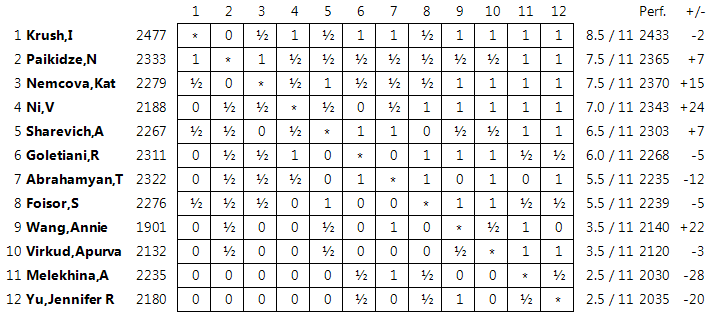 \
\
Replay Final Round
Select from the dropdown menu to replay the games
Commentary provided for the Chess Club and Scholastic Center of Saint Louis by Josh Friedel:
Joshua Friedel
Josh was born in 1986 in New Hampshire, USA and is currently living in Wisconsin. He obtained his international master title in 2005 and his grandmaster in 2008. He has participated in six US Championships, including a tie for fourth in 2008. Major Open tournament victories include: the 2003 Eastern Open, 2005 Berkeley Masters, 2008 National Open, 2009 Edmonton International, 2009 North American Open, 2010 Saint Louis Open, 2010 American Open, 2013 Chicago Open.
Josh will be annotating the games for the Saint Louis Chess Club. |
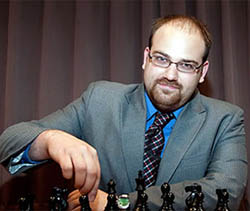 |
Photos by Lennart Ootes




























 \
\
